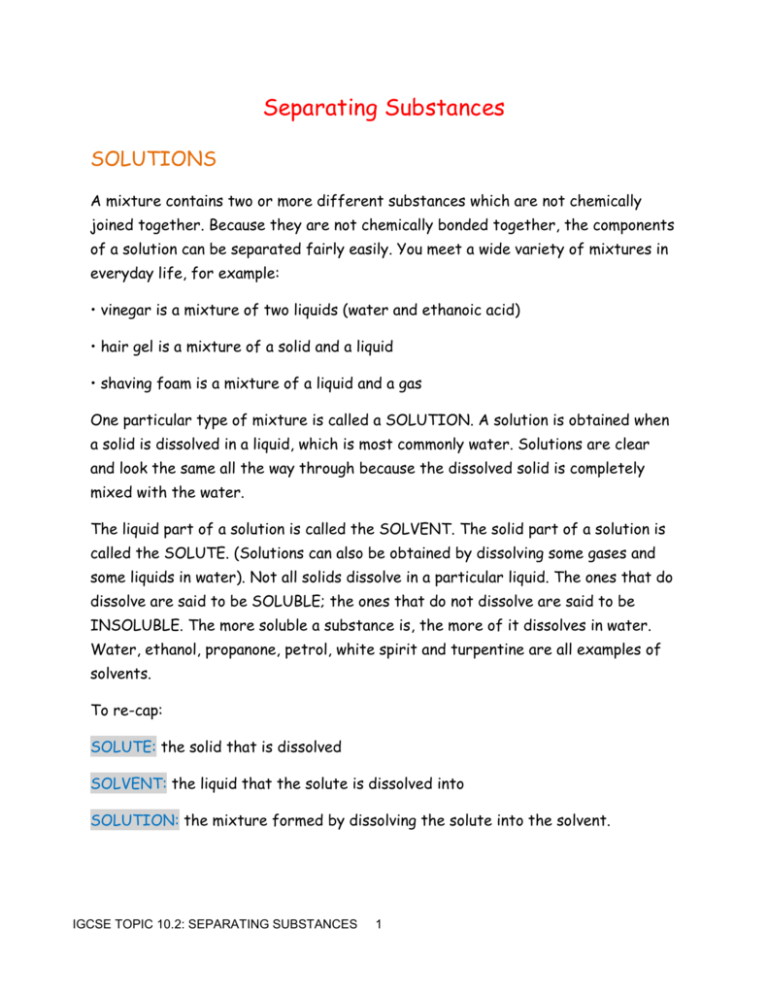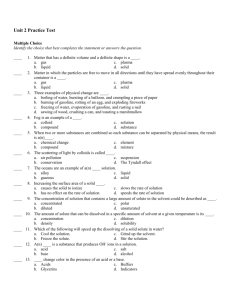Topic 2 Separating substances notes
advertisement

Separating Substances SOLUTIONS A mixture contains two or more different substances which are not chemically joined together. Because they are not chemically bonded together, the components of a solution can be separated fairly easily. You meet a wide variety of mixtures in everyday life, for example: • vinegar is a mixture of two liquids (water and ethanoic acid) • hair gel is a mixture of a solid and a liquid • shaving foam is a mixture of a liquid and a gas One particular type of mixture is called a SOLUTION. A solution is obtained when a solid is dissolved in a liquid, which is most commonly water. Solutions are clear and look the same all the way through because the dissolved solid is completely mixed with the water. The liquid part of a solution is called the SOLVENT. The solid part of a solution is called the SOLUTE. (Solutions can also be obtained by dissolving some gases and some liquids in water). Not all solids dissolve in a particular liquid. The ones that do dissolve are said to be SOLUBLE; the ones that do not dissolve are said to be INSOLUBLE. The more soluble a substance is, the more of it dissolves in water. Water, ethanol, propanone, petrol, white spirit and turpentine are all examples of solvents. To re-cap: SOLUTE: the solid that is dissolved SOLVENT: the liquid that the solute is dissolved into SOLUTION: the mixture formed by dissolving the solute into the solvent. IGCSE TOPIC 10.2: SEPARATING SUBSTANCES 1 Dissolving When a substance dissolves, the solute and the solvent simply mix. Dissolving is therefore known as a physical process as no new substances are formed. The diagram shows a model of sugar particles dissolving in water particles. As the sugar particles separate, the smaller water particles fit into the spaces between the larger sugar particles. The water and sugar particles are attracted to each other, so they move closer together when they are mixed. This is why the total volume is often slightly less than the volumes of the two separate components. Dissolving can be speeded up by heating the solvent up (sugar dissolves much faster in a hot cup of tea than in cold water). The hotter the solvent, the faster the molecules are moving, the more energy they have and the more collisions there between solvent and solute. The solute molecules will also have more energy. Stirring the mixture also speeds up dissolving as does grinding the solid into smaller pieces. Choosing a suitable separation method: Method of separation Used to separate Filtration Evaporation Crystallization Distillation Fractional distillation Chromatography a solid from a liquid a solid from a solution a solid from a solution a solvent from a solution liquids from each other different substances from a solution IGCSE TOPIC 10.2: SEPARATING SUBSTANCES 2 Purity Purity is important in drugs and foodstuffs since they cannot contain harmful substances. The ability to separate substances to obtain pure samples is therefore very important. The purity of a substance can be inferred from its melting point (m.p.) and boiling point (b.p.) after separation. All substances have a unique m.p. and b.p. which can be looked up in data books. Pure substances melt sharply at these temperatures. Compared to the data book, the lower the m.p. and/or higher the b.p. a substance is, the less pure it is. Impure substances also melt and boil over a range of temperatures (i.e. a few degrees) rather than changing sharply. METHODS OF SEPARATION Filtration The mixture goes in a funnel with filter paper, into a flask. The residue is insoluble and stays in filter paper. The filtrate, which is the soluble part, goes through the paper. IGCSE TOPIC 10.2: SEPARATING SUBSTANCES 3 Crystallisation Some water in the solution is evaporated so the solution becomes more concentrated. One drop is placed on a microscope slide to check if crystals are forming. The solution is left to cool and crystallise. Crystals are filtered to remove solvent. Evaporation To obtain a solute from a solution, another technique is evaporation. Here the solution is heated to remove solvent (often water) and leave the solute behind. Care must be taken to heat very gently near the end as the solute may decompose if heated too strongly. Simple distillation Distillation (left) evaporates a solvent from a solution leaving the solute behind. Fractional distillation Fractional distillation (right) removes a liquid from a mixture of liquids, because the liquids have different boiling points. Used to separate substances in crude oil and get ethanol from the products of fermentation. IGCSE TOPIC 10.2: SEPARATING SUBSTANCES 4 1) The mixture is heated to evaporate the substance with the lowest boiling point 2) Some of the other liquid(s) will evaporate too. A mixture of gases condense on the beads in the fractional column. So the beads are heated to the boiling point of the lowest substance in this case, so that the substance being removed cannot condense on the beads. The other substances continue to condense and will drip back into the flask. The beaker can be changed after every fraction. Paper chromatography To separate substances a drop of the mixture is placed at the centre of a piece of filter paper and allowed to dry. Three or four more drops are added to it. Water is dripped on, drip by drip, so the ink spreads creating different coloured circles. Paper + rings = chromatogram. Rings are created because different substances travel at different rates. (To identify substances) Spots of substances placed onto a pencilled line (as ink would separate) which is called the origin, and labelled. Paper goes in solvent, and solvent travels up paper, then paper is taken out. There are spots which have travelled different distances. Interpreting simple chromatograms 1) Number of rings/dots = number of substances 2) If two dots travel the same distance up the paper they are the same substance. 3) You can calculate the Rf value to identify a substance, given by the formula: Rf value = distance moved by substance distance moved by solvent IGCSE TOPIC 10.2: SEPARATING SUBSTANCES 5 To make colourless substances visible you use a locating agent: 1) Dry paper in oven 2) Spray it with locating agent 3) Heat it in the oven for 10 minutes. The stationary phase is the material on which the separation takes place (e.g. the paper). The mobile phase consists of the mixture you want to separate, dissolved in a solvent. Measuring purity Pure substances have a definite, sharp meting/boiling point; a substance + impurity has lower melting point and higher boiling point, at a range of temperatures; more impurity means bigger change. This is why salt is used on roads to prevent the formation of ice or to melt ice. IGCSE TOPIC 10.2: SEPARATING SUBSTANCES 6 Topic 2 Separating substances Summary questions 1 2 IGCSE TOPIC 10.2: SEPARATING SUBSTANCES 7 3 4 (ii) On the diagram above fractions X and Y have not been named. State the name of Fraction X …………………………………………………. Fraction Y …………………………………………………. IGCSE TOPIC 10.2: SEPARATING SUBSTANCES 8 5 6 IGCSE TOPIC 10.2: SEPARATING SUBSTANCES 9 7 IGCSE TOPIC 10.2: SEPARATING SUBSTANCES 10






